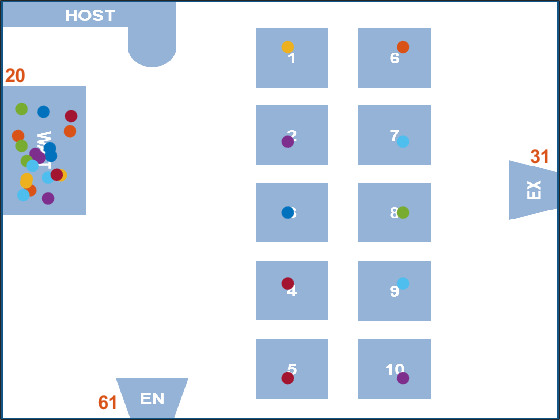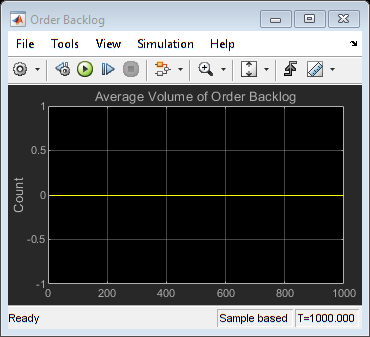Resource Pool
Pool entity resources
Libraries:
SimEvents /
Entity Management
SimEvents
Description
The Resource Pool block defines resources that entities can use during model simulation. Use the Resource Acquirer and Resource Releaser blocks to work with these resources.
Initialize the block with the specified amount of available resources. Then:
Use one or more Resource Acquirer blocks to reserve those resources.
Use a Resource Releaser block to return resources back to this block for future use.
You can determine the visibility of available resources in a model hierarchy. You can
choose Global or Scoped resources
in the pool.
Global— Resources can be referenced from anywhere in a model hierarchy.Scoped— Resources are locally visible and can be referenced only from the subsystem that contains the Resource Pool block and all the subsystems inside.
Examples
Using Custom Visualization for Entities
These examples show how you can create MATLAB®-based custom visualization for entities. The example illustrates the visualization of a restaurant layout with customer entities entering, dining, and leaving.
Resource Allocation from Multiple Pools
A technique for allocating resources from multiple resource pools. It shows how to choose a pool from which to draw a resource, based on given criteria.
Optimization of Shared Resources in a Batch Production Process
Identify resource deficiencies and improve capacity planning in a system that shares resources.
Ports
Input
Input entity port for changing resource amount. The input cannot be a negative value.
Dependencies
To enable this port, select the Change amount through
control port as the Resource amount
source.
Data Types: single | double | int8 | int16 | int32 | int64 | uint8 | uint16 | uint32 | uint64 | Boolean | fixed point
Output
Number of resources that are in use.
Dependencies
To enable this port, click the Statistics tab and select the box labeled Amount in use, u.
Data Types: double
Average wait time the pool is utilized.
Dependencies
To enable this port, click the Statistics tab and select the box labeled Average utilization, util.
Data Types: double
Number of resources that are available.
Dependencies
To enable this port, click the Statistics tab and select the box labeled Amount available, avail.
Data Types: double
Parameters
Enter name of entity resource.
Programmatic Use
Block Parameter:
ResourceName |
| Type: character vector |
Values:
'Resource1' | character vector |
Default:
'Resource1' |
Select granularity of resource use.
Discrete unit— Use whole number increment.Fractional amount— Use fractional increment.
Programmatic Use
Block Parameter:
ResourceGranularity |
| Type: character vector |
Values: 'Discrete
unit' | 'Fractional amount'
|
Default: 'Discrete
unit' |
Select this check box to allow this resource to return to the resource pool upon release. An example of such a resource is a table in a restaurant, which is available for reuse when a customer leaves.
Clear this check box to prevent this resource from returning to the resource pool upon release. In this case, when the resource is released, it is no longer available in the resource pool. An example of such a resource is food in a restaurant, which is not reusable upon consumption.
Programmatic Use
Block Parameter:
ReusableUponRelease |
| Type: character vector |
Values: 'on'
| 'off' |
Default:
'off' |
Select resource amount source.
DialogChange amount through control portSelect this option to enable an input entity port and a variable capacity resource. The payload of the arriving message increments the existing number of resources for the block. For example, if the resource pool has five resources, and a message with a payload of three arrives at the input port, the block has eight resources available. The number of resources cannot decrement.
Programmatic Use
Block Parameter:
ResourceAmountSource |
| Type: character vector |
Values:
'Dialog' | 'Change amount through
control port'
|
Default:
'Dialog' |
Enter amount of resource.
Dependencies
Select the Dialog to enable the
Resource amount source.
Programmatic Use
Block Parameter:
ResourceAmount |
| Type: character vector |
Values: '10'
| scalar |
Default:
'10' |
Enter initial amount of resource.
Dependencies
Select the Change amount through control
port to enable the Resource amount
source.
Programmatic Use
Block Parameter:
InitialResourceAmount |
| Type: character vector |
Values: '10'
| scalar |
Default:
'10' |
Choose the behavior of the resources acquired from this pool as
Global or
Scoped.
When Global is selected:
Resource pool names must be unique in the model.
All resources have global scope and they can be referenced from anywhere in a model hierarchy.
An entity carrying a resource acquired from this block, must explicitly relinquish the resource.
When an entity is destroyed, the resources that are associated with it are returned to the pool, if the Reusable upon release check box is selected.
When Scoped is selected:
Resources are locally visible and can be referenced only from the subsystem that contains the Resource Pool block and all the subsystems inside.
Resource pool names must be unique within the model hierarchy where the Resource Pool block is visible.
An entity carrying the resource acquired from this block, must explicitly relinquish the resource.
When an entity leaves the scope, any resources that are local to that scope and not already released, are automatically released. If Reusable upon release check box is selected, they are returned to the pool.
Programmatic Use
Block Parameter:
InitialResourceAmount |
| Type: character vector |
Values: '10'
| scalar |
Default:
'10' |
Outputs the amount of resources that the block has acquired and has not
yet released. For example, if the resource pool has 10
resources, and the entity acquires all of them, this port shows
10. When the block releases the resources, this port
shows 0.
Programmatic Use
Block Parameter:
AmountInUse |
| Type: character vector |
Values: 'on'
| 'off' |
Default:
'off' |
Outputs the average resource utilization.
Programmatic Use
Block Parameter:
AverageUtilization |
| Type: character vector |
Values: 'on'
| 'off' |
Default:
'off' |
Outputs the amount of resources available.
Programmatic Use
Block Parameter:
AmountAvailable |
| Type: character vector |
Values: 'on'
| 'off' |
Default:
'off' |
Version History
Introduced in R2016a
MATLAB Command
You clicked a link that corresponds to this MATLAB command:
Run the command by entering it in the MATLAB Command Window. Web browsers do not support MATLAB commands.
选择网站
选择网站以获取翻译的可用内容,以及查看当地活动和优惠。根据您的位置,我们建议您选择:。
您也可以从以下列表中选择网站:
如何获得最佳网站性能
选择中国网站(中文或英文)以获得最佳网站性能。其他 MathWorks 国家/地区网站并未针对您所在位置的访问进行优化。
美洲
- América Latina (Español)
- Canada (English)
- United States (English)
欧洲
- Belgium (English)
- Denmark (English)
- Deutschland (Deutsch)
- España (Español)
- Finland (English)
- France (Français)
- Ireland (English)
- Italia (Italiano)
- Luxembourg (English)
- Netherlands (English)
- Norway (English)
- Österreich (Deutsch)
- Portugal (English)
- Sweden (English)
- Switzerland
- United Kingdom (English)


